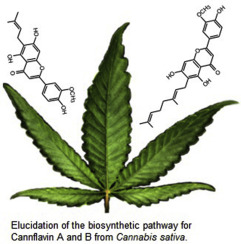当前位置:
X-MOL 学术
›
Phytochemistry
›
论文详情
Our official English website, www.x-mol.net, welcomes your feedback! (Note: you will need to create a separate account there.)
Biosynthesis of cannflavins A and B from Cannabis sativa L
Phytochemistry ( IF 3.2 ) Pub Date : 2019-08-01 , DOI: 10.1016/j.phytochem.2019.05.009 Kevin A Rea , José A. Casaretto , M. Sameer Al-Abdul-Wahid , Arjun Sukumaran , Jennifer Geddes-McAlister , Steven J. Rothstein , Tariq A. Akhtar
Phytochemistry ( IF 3.2 ) Pub Date : 2019-08-01 , DOI: 10.1016/j.phytochem.2019.05.009 Kevin A Rea , José A. Casaretto , M. Sameer Al-Abdul-Wahid , Arjun Sukumaran , Jennifer Geddes-McAlister , Steven J. Rothstein , Tariq A. Akhtar

|
In addition to the psychoactive constituents that are typically associated with Cannabis sativa L., there exist numerous other specialized metabolites in this plant that are believed to contribute to its medicinal versatility. This study focused on two such compounds, known as cannflavin A and cannflavin B. These prenylated flavonoids specifically accumulate in C. sativa and are known to exhibit potent anti-inflammatory activity in various animal cell models. However, almost nothing is known about their biosynthesis. Using a combination of phylogenomic and biochemical approaches, an aromatic prenyltransferase from C. sativa (CsPT3) was identified that catalyzes the regiospecific addition of either geranyl diphosphate (GPP) or dimethylallyl diphosphate (DMAPP) to the methylated flavone, chrysoeriol, to produce cannflavins A and B, respectively. Further evidence is presented for an O-methyltransferase (CsOMT21) encoded within the C. sativa genome that specifically converts the widespread plant flavone known as luteolin to chrysoeriol, both of which accumulate in C. sativa. These results therefore imply the following reaction sequence for cannflavins A and B biosynthesis: luteolin ► chrysoeriol ► cannflavin A and cannflavin B. Taken together, the identification of these two unique enzymes represent a branch point from the general flavonoid pathway in C. sativa and offer a tractable route towards metabolic engineering strategies that are designed to produce these two medicinally relevant Cannabis compounds.
中文翻译:

从 Cannabis sativa L 生物合成大麻素 A 和 B
除了通常与 Cannabis sativa L. 相关的精神活性成分外,这种植物中还存在许多其他特殊代谢物,据信这些代谢物有助于其药用多功能性。这项研究的重点是两种这样的化合物,称为 cannflavin A 和 cannflavin B。这些异戊二烯化的黄酮类化合物专门在 C. sativa 中积累,并且已知在各种动物细胞模型中表现出有效的抗炎活性。然而,关于它们的生物合成几乎一无所知。使用系统基因组学和生化方法的组合,鉴定了一种来自 C. sativa (CsPT3) 的芳香异戊二烯转移酶,该酶催化香叶基二磷酸 (GPP) 或二甲基烯丙基二磷酸 (DMAPP) 区域特异性添加到甲基化黄酮、金黄素,以产生大麻素 A和 B 分别。进一步的证据表明,在苜蓿基因组中编码的 O-甲基转移酶 (CsOMT21) 可以特异性地将广泛存在的植物黄酮(称为木犀草素)转化为金黄酮,这两种物质都在苜蓿中积累。因此,这些结果暗示了大麻素 A 和 B 生物合成的以下反应顺序:木犀草素 ► 金黄素 ► 大麻素 A 和大麻素 B。 总之,这两种独特酶的鉴定代表了苜蓿中一般类黄酮途径的一个分支点,并提供一种易于处理的代谢工程策略,旨在生产这两种与药用相关的大麻化合物。sativa 基因组专门将广泛存在的植物黄酮(称为木犀草素)转化为 chrysoeriol,两者都在 C. sativa 中积累。因此,这些结果暗示了大麻素 A 和 B 生物合成的以下反应顺序:木犀草素 ► 金黄素 ► 大麻素 A 和大麻素 B。 总之,这两种独特酶的鉴定代表了苜蓿中一般类黄酮途径的一个分支点,并提供一种易于处理的代谢工程策略,旨在生产这两种与药用相关的大麻化合物。sativa 基因组专门将广泛存在的植物黄酮(称为木犀草素)转化为 chrysoeriol,两者都在 C. sativa 中积累。因此,这些结果暗示了大麻素 A 和 B 生物合成的以下反应顺序:木犀草素 ► 金黄素 ► 大麻素 A 和大麻素 B。 总之,这两种独特酶的鉴定代表了苜蓿中一般类黄酮途径的一个分支点,并提供一种易于处理的代谢工程策略,旨在生产这两种与药用相关的大麻化合物。
更新日期:2019-08-01
中文翻译:

从 Cannabis sativa L 生物合成大麻素 A 和 B
除了通常与 Cannabis sativa L. 相关的精神活性成分外,这种植物中还存在许多其他特殊代谢物,据信这些代谢物有助于其药用多功能性。这项研究的重点是两种这样的化合物,称为 cannflavin A 和 cannflavin B。这些异戊二烯化的黄酮类化合物专门在 C. sativa 中积累,并且已知在各种动物细胞模型中表现出有效的抗炎活性。然而,关于它们的生物合成几乎一无所知。使用系统基因组学和生化方法的组合,鉴定了一种来自 C. sativa (CsPT3) 的芳香异戊二烯转移酶,该酶催化香叶基二磷酸 (GPP) 或二甲基烯丙基二磷酸 (DMAPP) 区域特异性添加到甲基化黄酮、金黄素,以产生大麻素 A和 B 分别。进一步的证据表明,在苜蓿基因组中编码的 O-甲基转移酶 (CsOMT21) 可以特异性地将广泛存在的植物黄酮(称为木犀草素)转化为金黄酮,这两种物质都在苜蓿中积累。因此,这些结果暗示了大麻素 A 和 B 生物合成的以下反应顺序:木犀草素 ► 金黄素 ► 大麻素 A 和大麻素 B。 总之,这两种独特酶的鉴定代表了苜蓿中一般类黄酮途径的一个分支点,并提供一种易于处理的代谢工程策略,旨在生产这两种与药用相关的大麻化合物。sativa 基因组专门将广泛存在的植物黄酮(称为木犀草素)转化为 chrysoeriol,两者都在 C. sativa 中积累。因此,这些结果暗示了大麻素 A 和 B 生物合成的以下反应顺序:木犀草素 ► 金黄素 ► 大麻素 A 和大麻素 B。 总之,这两种独特酶的鉴定代表了苜蓿中一般类黄酮途径的一个分支点,并提供一种易于处理的代谢工程策略,旨在生产这两种与药用相关的大麻化合物。sativa 基因组专门将广泛存在的植物黄酮(称为木犀草素)转化为 chrysoeriol,两者都在 C. sativa 中积累。因此,这些结果暗示了大麻素 A 和 B 生物合成的以下反应顺序:木犀草素 ► 金黄素 ► 大麻素 A 和大麻素 B。 总之,这两种独特酶的鉴定代表了苜蓿中一般类黄酮途径的一个分支点,并提供一种易于处理的代谢工程策略,旨在生产这两种与药用相关的大麻化合物。






































 京公网安备 11010802027423号
京公网安备 11010802027423号